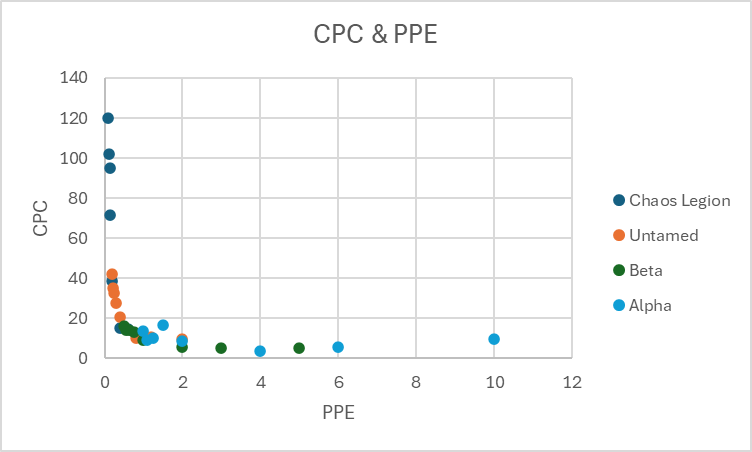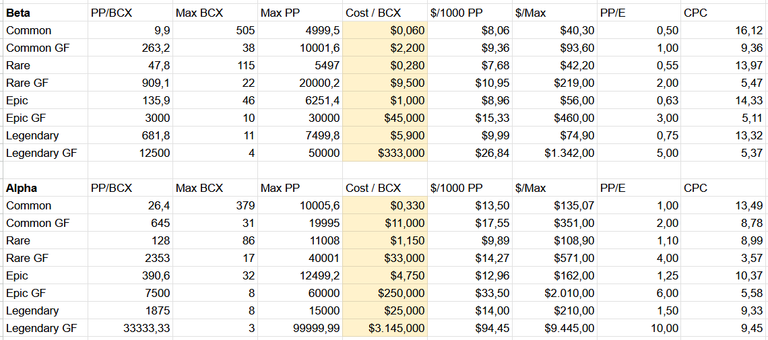LPE and ROI - UNITE!

In my last post, I talked extensively about ROI in Splinterlands, and in my last Land-Post, about ROI on Land and why I think that the LPE-Metric is not prevalent to new players.
LPE and ROI are two different things. LPE focuses on the production efficiency of plots, while my ROI calculations refer to the monetary cost of the production.
A higher LPE does not mean necessarily a higher ROI:
Beta Rare Gold foil. I pay $220 for a max, giving me 20,000 PP. That is 90 PP/$.
.
[lots of math]
.
ROI: 220,296 / 2,360,000 = 9,3% per year (vs. 12,1% with Rare Beta RF)
.
BUT LPE = 25,148 / 2 = 12,574 (vs. 3.501 DEC/h/Plot with Rare Beta RF)
.
So, the yROI of my simulation goes down, but LPE goes up substantially.
.
Hence, higher LPE does not equal higher yROI - that if I calculated somewhat correctly here :-D

Card Staking Efficiency
As I went through Azircons Post about Folks with 5 plots, I noticed that one player had an incredibly high amount of PP for only 5 plots. Naturally, I went to see how and why and found another, quite logical, coefficient that might help in Land calculations:
PP / Energy
Also PP per DEC staked. This one tells us how efficiently a card works on our land. The more PP you have on a plot, the more efficient it runs.
Now, why?
This is the one that can help to connect ROI and LPE. For a high LPE, you also need cards with a high PPE. Alpha Legendary GF cards for example have an PPE of 10 (meaning they give 10 PP for each DEC staked), and those are also the cards that boost your LPE to the sky.
For a good ROI, you also need a high PPE, as the staked Energy has to be taken into account, too, and this assures that you get more resources out of your plot.
If we now connect PPE with ROI, we get a metric that tells us what the most efficient card is both on Land as for the money we put in.
Few notes:
- $/1000 PP and $/Max includes the DEC needed to be staked
- The Cost/BCX is taken from the first non-neutral card and does not include terrain bonus.
- The prices are momentary. You can download the sheet and actualize them yourself if wanted.
Following this chart, the biggest bang for the buck here would be Beta Rare RF with 7,68$ per 1000 PP. They have a PPE ratio of 0,55 PP per DEC. If we now put those to into relation, by dividing the cost by PPE, we get:

The Cost-Production-Coefficient (CPC)
I guess the correct term would be: Cost per 1000 Production Points per Production Points Per Energy.
As it is a cost-denominated coefficient, and we want the lowest cost, so the lower the CPC, the better is that card suited to boost both our ROI as well as our LP in a balanced way.
Here are the 5 best card types at the moment:
| Type | Cost/1000PP | PP/E | CPC | |
|---|---|---|---|---|
| Alpha Rare GF | $14,27 | 4 | 3,57 | |
| Beta Epic GF | $15,33 | 3 | 5,11 | |
| Beta Legendary GF | $26,84 | 5 | 5,37 | |
| Beta Rare GF | $10,95 | 2 | 5,47 | |
| Alpha Epic GF | $33,50 | 6 | 5,58 |
Best of other Editions:
| Type | Cost/1000PP | PP/E | CPC | |
|---|---|---|---|---|
| Untamed Legendary GF | $19,50 | 2 | 9,75 | |
| Chaos Legion Legendary GF | $11,49 | 1 | 11,49 |

Plotting CPC against PPE you can see that most of the cards with a high PPE have also a low CPC. Meaning, a high PPE is already an indicator for a good deal. But CPC takes into account the cost as well:

Here again you can see that most of the better CPC are on the higher end of costs, considering the mass is around 10$/1000 PP. But the concept of the CPC is to find a balance, so again, the best CPC is not an outlier, but at 15$/1000 PP.

Conclusion
The CPC is not meant to be the one decisive metric. It always depends on what's available on the market anyway. But it can help a lot when one wants to take into account both real life money as well as in-game land efficiency.
My favorite card type, Beta Rares, have a relatively high CPC with 13,97, but still stick out with the low Cost/BCX of $7,68. I might be switching to Beta Rare GF.
I'd say that best case is a card with a CPC between 5 and 10. 10 to 20 is more affordable than efficient, and over 20 is not really worth it.
The Alpha Rare GF are quite expensive at the moment, as there are no 1 BCX cards - that, too has to be taken into account. The CPC is calculated with the cost per 1000 PP, but that doesn't mean that there are cards with only 1000 PP.
I hope you can see all the formula in the sheet that is linked, in case you want to use it as well. I certainly will.

What do you think?
Is this coefficient helpful to land owners that just started?
Is the CPC a good balance?
I'm open to any other proposals as well 🙃

Delegate Tokens and HP to Fallen Angels to earn weekly rewards!
Delegate | Join to the guild
There is a reason I stay away from cost and therefore ROI.
Cost is personal. Also it is highly variable when a card is concerned. I have know way of knowing how much you have spend on a particular card in the past. Especially more many that would be years in the past. Also they would have combined the cards during various times...........so I stay away from cost of cards.
However, for an individual, like you, you can surely calculate this, as you know exactly how much you paid.
ROI is a personal item. You can calculate your own ROI.
My goal is to calculate metric NOT for me but for others. So I must come up with a metric that is public knowledge and can be easily shared for everyone.
I got that, hence I opened the Sheet for everyone to use for their personal decision making. Many things can happen over time as well, Black Swan events and such, that make it very difficult. But a calculation like this can at least help to make a decision in the present. Of course, everyone has to be aware that things can go to the moon, or just become worthless - that is also referred to in-game. What if tomorrow the price for stone and other resources plummets? Suddenly, the LPE numbers would plummet, too, as they're bound to the DEC earned with the plots. If that DEC goes down, so does the LPE.
Hence, I like the PP/E ratio better to determine the efficiency of a plot. It's stable, it won't change. Like the LCE I think? But the PPE is easier to understand for me, and easier to read as it's lower than the LCE.
The CPC is just a little helper to determine what a card bought now can do for the PP/E ratio.
That's a good idea to visualize. I still have to start thinking in diagrams... I'm more thinking in tables at the moment.
That looks somewhat like mine! But it's Cost/Productivity Coefficient, not cost per card.
IF DEC loses peg in a big way, then you are TOAST :)
So is your LPE if resources crash :-D And even if DEC crashes, I'll still have gotten the best deal at the time. Can't predict the market anyway. And if I have to bet, I bet on the Flywheel starting sooner or later.
LPE is just a metric. It will still generate a number
Land Plot Efficiency (LPE) = (Total DEC Equivalent generated/hr) / (Number of active Plots)
It is priced in DEC. It doesn't care what happens to DEC. It does care about price of resources, if their value drops drastically, which can happen if people stop producing all resources, and keep selling them (I don't know why they would do that) then LPE goes up.
Anyways, I think a bubble chart could be better visually
Exactly my point. While my calculations are tied to DEC/$ Ratio, your's are tied to DEC/Resource ratio. I just hope that neither gets down :-D
And the LPE would go up? Doesn't it mean that less DEC is produced per plot, and it goes down?
Thanks for sharing! - @azircon
